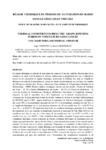Please use this identifier to cite or link to this item:
http://www.alice.cnptia.embrapa.br/alice/handle/doc/1049968| Title: | Régime thermique en période de maturation du raisin dans le géoclimat viticole. |
| Authors: | TONIETTO, J.  CARBONNEAU, A.   |
| Affiliation: | JORGE TONIETTO, CNPUV; Alain Carbonneau. |
| Date Issued: | 2002 |
| Citation: | In: SYMPOSIUM INTERNATIONAL SUR LE ZONAGE VITIVINICOLE, 4, 2002, Avignon, França. Résumés.... Inter Rhône e Office International de la Vigne et du Vin - O.I.V. Tome I, p.279-289. |
| Description: | Mots clés :indice de fraîcheur des nuits, amplitude thermique, Système CCM Géoviticole, zonage, qualité. Key words: cool night index, thermal amplitude, MCC System for World Viticulture, zoning, quality. RESUME Le régime thermique en période de maturation du raisin est l?une des variables déterminantes de la coloration du raisin et de la richesse en arômes, anthocyanes et polyphénols des vins. L?objectif du travail est de caractériser le régime thermique, notamment la fraîcheur des nuits et l?amplitude thermique au cours de la maturation, au niveau du climat viticole mondial, sur une base des données de 100 régions viticoles dans 30 pays, obtenue par l?intermédiaire de l?Organisation Mondiale de la Météorologie - OMM. Plusieurs indices climatiques viticoles ont été calculés: l?Indice de Fraîcheur des Nuits ?IF (ºC), l?Indice Héliothermique de Huglin ?IH (ºC) et l?Indice de Sécheresse ?IS (mm) du Système de Classification Climatique Multicritères Géoviticole, et l?amplitude thermique moyenne en août et septembre Aa-s (ºC). Egalement, sur la période véraison-récolte ?v-r(moyenne des 30 jours précédant la date de récolte, estimée sur la base d?un Indice Héliothermique de HUGLIN égal à 1.900 - approximatif pour la maturation du Cabernet-Sauvignon): la fraîcheur des nuits (FNv -r), la température moyenne de l?air (Tv-r), la température maximale de l?air (Txv-r) et l?amplitude thermique (Av-r). Les résultats montrent que IH est corrélé avec Tv-r (r=0,79**) et avec Txv-r (r=0,80**). IH représente donc bien les conditions thermiques générales de la période de maturation en ce qui concerne la température moyenne et maximale de l?air. Mais IH n?est pas corrélé ni avec Aa-s ni avec Av-r. Par contre, IF est corrélé avec Aa-s (r=-0,70**) et FNv-r est corrélé avec Av-r (r=-0,69**). Cette corrélation doit justifier, en partie, l?usage assez courant de l?amplitude thermique comme indicateur de bonnes conditions thermiques de maturation pour les régions qui présentent des valeurs élevées. Mais ce raisonnement peut amener à des caractérisations erronées. Le travail met en évidence, également, ?importance de considérer le bilan hydrique des régions (IS) dans l?analyse du régime thermique sur la qualité du raisin. On peut onclure que pour avoir une bonne caractérisation du régime thermique en période de maturation il faut considérer la fraîcheur des nuits (IF étant un bon indicateur de FNv-r moyen des régions, avec un r=0,80**), caractérisation qui peut être améliorée avec l?information des températures maximales et de sur 11l?amplitude thermique en période de maturation du raisin. Les éléments présentés peuvent servir à améliorer les indices climatiques pour estimer le potentiel qualitatif du raisin des différentes régions viticoles, notamment en complément de IF. ABSTRACT The thermal conditions during the grape ripening period are important variables related to colour of the grapes, anthocyanins, polyphenols and flavour of the wine. The main purpose of this work was to characterise the thermal conditions, especially the night coolness and the thermal amplitude during maturation, in the geoclimate of the world vine culture. A database of 100 grape-growing regions of 30 countries obtained from the World Meteorology Organisation (WMO) was used. Some climatic indexes were calculated: Cool Night Index ?IF (°C), Huglin?s Heliothermal Index ?IH (°C) and Dryness Index ?IS (mm), from the Multicriteria Climatic Classification System for World Viticulture, and the thermal amplitude in August and September Aa-s (°C). Over véraison-harvest period ?v-r(mean of the 30 days before harvesting date, estimated on the basis of HUGLIN Heliothermal Index equal to 1,900 ? approximately value to ripen Cabernet-Sauvignon) similar indexes were obtained: the cool night (FNv-r), the mean air temperature (Tv-r), the maximal air temperature (Txv-r) and the thermal amplitude (Av-r). The results showed that IH is positively correlated with Tv-r (r=0.79**), Txv-r (r=0.80)and IF (r=0.67**). Therefore, IH represents well the general thermal conditions during maturation period, specially concerning the mean and the maximal air temperature. owever, IH was correlated neither with Aa-s nor to Av-r. IF was negatively correlated with Aa-s (r= -0.70**) and FNv-r was negatively correlated with Av-r (r=-0.69**). The correlation to some extent explains the current use of the thermal amplitude to predict good ripening thermal conditions for those regions that show high values. As here we have described, this thinking may give incorrect results. This work has also showed the importance to consider the water balance of the regions (IS) in the effect of the thermal conditions in grape quality. We conclude that the characterisation of the thermal conditions during the ripening period do need the cool night index (in this case, IFis a good index to provide the mean FNv-r of the regions, r=0,80**). Factors other than cool night which influence this characterisation are both maximal air temperature and thermal amplitude data. The elements presented in this work, in addition to IF , may improve the climatic indexes to be used to predict the qualitative potential of grapes from different regions. |
| Thesagro: | Clima Viticultura |
| NAL Thesaurus: | zoning |
| Keywords: | MCC System for World Viticulture Cool night index Thermal amplitude Quality |
| Type of Material: | Artigo em anais e proceedings |
| Access: | openAccess |
| Appears in Collections: | Artigo em anais de congresso (CNPUV)  |
Files in This Item:
| File | Description | Size | Format | |
|---|---|---|---|---|
| CBVE91999P111toniettosizv4.pdf | 48.19 kB | Adobe PDF |  View/Open |









